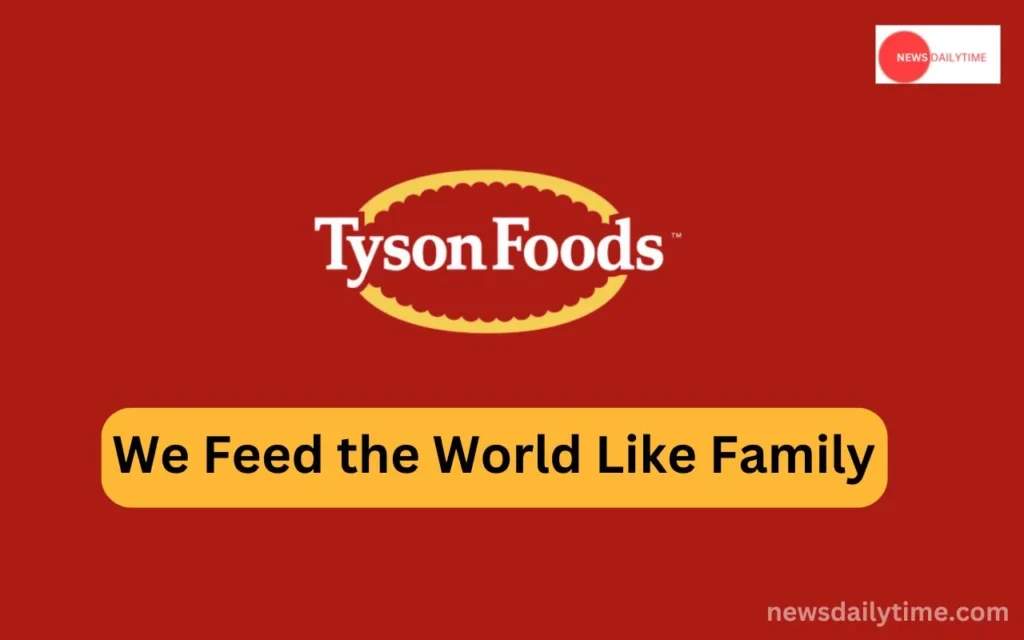Chicken nuggets come from a vast planet, although you may not realise it as you bite them. Tyson Foods, the largest US meat firm, supplies one in five pounds of chicken, beef, and pigs. Discover how this meat titan becomes America’s protein powerhouse behind the scenes. After learning about Tyson, you may view your chicken differently at supper.
Tyson’s Meat Production and Processing
Tyson Foods, America’s largest meat producer, sells beef, chicken, and pork worldwide. Tyson runs vast factory farms and slaughterhouses nationwide to meet demand.
Beef Production
Tyson raises cattle in feedlots with thousands of animals. Grains are fed to cattle to fatten them quickly for slaughter. Tyson’s beef processing factories stun, bleed, and butcher the cattle. The meat is packaged and sold.
Chicken farming
Tyson produces chickens more intensively. Massive warehouses hold hundreds of thousands of birds. The hens’ harsh confinement and rapid growth often cause health problems. Once mature, chickens are strung up by their legs and bled in processing plants after 6-7 weeks. Tyson foods farms produce billions of pounds of chicken meat annually.
Pork Production
Tyson mass-produces pork on enormous pig farms and processing plants. Mother pigs live in boxes too small to turn around. Their piglets are seized and fattened in packed enclosures a few weeks after birth. Tyson’s pork processing factories slaughter, cut, and package mature pigs for delivery using high-speed automated technology. To address the demand for cheap meat, Tyson remarkably processes vast numbers of beef, poultry, and pork.
Ranking the Fastest 40-Yard Dashes at the NFL Combine 2024
— News Daily Time (@time_daily66425) June 27, 2024
That NFL Combine moment when prospects line up for the. He positions himself, creating tension. It was his chance to show scouts from every team his raw speed. Some. pic.twitter.com/BCSnvAcrto
Tyson Foods Earning
Feb. 5 Tyson (TSN.N) opens new tab, announced better-than-expected quarterly earnings on Monday, and said U.S. factory reductions are helping its chicken business, driving shares to a nine-month high.
As investors digested management’ warnings that the manufacturer of Jimmy Dean sausages and Ball Park hot dogs must improve operations and confront unclear demand from consumers still struggling with high prices, shares rose 1.6%, off earlier highs.
Tyson’s beef business lost money as prices rose and U.S. cow supply fell to their lowest level in 70 years.
“We’ve taken some steps in the right direction, but we have a lot of work to do,” CEO Donnie King said in a conference call.
Over the previous year, the Arkansas-based corporation eliminated five poultry processing units and two beef cutting and packaging factories to improve outcomes. It will close another chicken plant this year.
Chief Financial Officer John R. Tyson said more closures are possible in an interview.
We’re seeing the consequences of modifying our footprint, they stated.
Tyson’s first-quarter adjusted operating profits declined 9.2% to $411 million.
An over 150% increase in chicken unit adjusted income to $192 million. However, Tyson’s chicken prices fell 3.9%, and sales fell 1.5%.
“While we’re cautiously optimistic about chicken, there remains a lot of uncertainty and a lot of time left in the year,” conference call speaker John R. Tyson, the company’s great-grandson.
He said harsh weather affected all second-quarter segments.
Tyson’s beef unit lost $117 million in the first quarter, compared to $129 million last year. Executives reported $56 million in inventory losses due to cattle futures declines.
Beef sales surged 6.4% as prices rose 10.5% and volumes declined 4.1%. After drought-restricted grazing lands, ranchers cut cow herds, raising prices.
JPMorgan analyst Ken Goldman said the beef segment margin was slightly disappointing, but not enough to outweigh excellent results elsewhere.
In a year of abundant hog supply, Tyson’s pork volume rose 7.7% while prices fell 8.5%.
Overall adjusted earnings of 69 cents per share surpassed analysts’ 41-cent estimate. LSEG statistics showed net sales up 0.4% to $13.32 billion, above $13.27 billion projections.
The Future of Tyson Foods
Tyson, one of the world’s top meat producers, shapes food’s destiny. Tyson must evolve to stay competitive as consumers demand more sustainable and humane practices.
Alternative Protein Innovation
Tyson aggressively invests in plant-based and cultured meat. Their Raised & Rooted brand makes pea protein nuggets and burger patties. Memphis Meats, which makes cell-grown meat, has also received their support. These actions indicate Tyson intends to enter the fast-growing alternative meat sector. Raised & Rooted products will likely increase in stores, and Tyson will invest more in meat substitutes.
Prioritize Sustainability
How food is made matters more to consumers. Tyson foods must operate sustainably to fulfill demand. They want lower emissions, waste, and animal welfare. Tyson will source sustainable ingredients, improve plant energy efficiency, and give birds more space. Tyson’s success depends on achieving these aims.
International Growth
Although Tyson’s primary business is in the U.S., international sales provide tremendous development potential. Tyson operates in China, South Korea, Taiwan, and Thailand and may expand into emerging Asian, South American, and Middle Eastern markets. Tyson can reach more clients globally by entering new markets and diversifying revenue streams.
Tyson Foods has dominated the meat sector for decades but confronts new threats. Tyson’s food leadership will depend on its ability to adapt to sustainability, alternative proteins, and worldwide expansion. Tyson has the scale and resources to adjust to these changes, but only time will tell if they do so swiftly and effectively. Dedication to sustainable, ethical practices and strategic investments in new technology will determine this meat giant’s future.
Conclusion
The skinny on Tyson Foods, America’s biggest meat producer. Tyson’s climb from humble beginnings to industry titan has been full of success and controversy. Concerns about their environmental impact, worker treatment, and company policies linger despite their production innovations and household recognition. Tyson supplies 20% of America’s poultry, beef, and pork, so they’re going nowhere soon. Consumers have authority over what and where they buy. You should research and decide on Tyson. Do not be afraid to raise tough questions—demand openness from major brands. Our food system’s future begins with us.
Stay updated and related make money online, Affiliate Marketing visit Quickearneronline.
FAQs
What does Tyson Foods make?
Modern, multi-national, protein-focused Tyson goods produce 20% of the US’s beef, pig, and poultry and a portfolio of goods under the Tyson®, Jimmy Dean®, Hillshire Farm®, BallPark®, Wright®, Aidell’s®, and State Fair® brands.
Does KFC utilize Tyson chicken?
It serves KFC, Taco Bell, McDonald’s, Burger King, small restaurants, and jails with chicken. At its 123 food processing factories, the corporation makes many processed meat products.
Which Tyson Foods subsidiaries?
Food brands include Jimmy Dean, Hillshire Farm, Ball Park, Wright Brand, Aidells, and State Fair. The 2020 Fortune 500 ranks US companies by revenue and ranks Tyson 79th. Springdale, Arkansas – Tyson dinners.
Has Tyson used genuine meat?
Their plants contain one in five pounds of U.S. chicken, beef, and pig. Tyson meals stands out for its fast and safe meat-to-table process.
Who owns Tyson?
US customers eat one in five pounds of beef, pig, and poultry from Tyson meals, one of the top four meat businesses. Since 1931, chairman John H. Tyson—grandson of founder John W.—has overseen the family business.
Read More: How Many Children Does Ryan Gosling Have?



